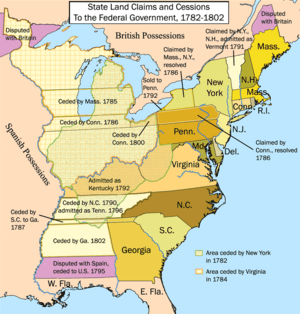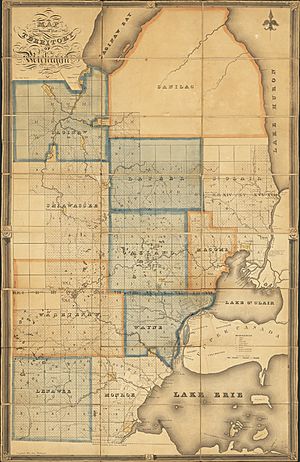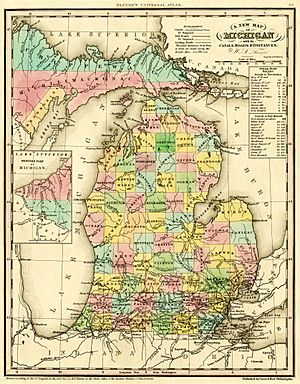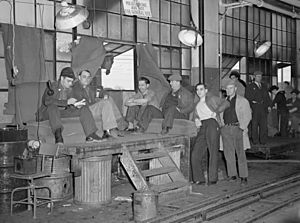History of Michigan facts for kids
The story of human activity in Michigan, a U.S. state in the Great Lakes, began with Native Americans. They settled the western Great Lakes area around 11,000 BCE. The first Europeans to arrive were the French. Explorer Etienne Brule traveled through Michigan in 1618. He was looking for a route to China.
Soon, the French claimed the land. They began trading furs with the local Native Americans. Men called "voyageurs" traveled rivers by canoe. They traded goods for furs, which were valuable in Europe. European exploration of Michigan started around 1620. The area was part of French Canada from 1668 to 1763.
In 1701, French officer Antoine de la Mothe Cadillac founded a settlement. It was called Fort Pontchartrain du Détroit, now the city of Detroit. After France lost the French and Indian War, Britain took control in 1763. The American Revolutionary War ended with the Treaty of Paris (1783). This treaty gave the United States land east of the Mississippi River. Michigan became part of the "Old Northwest."
From 1787 to 1800, Michigan was part of the Northwest Territory. Then, it joined the Indiana Territory in 1800. In 1805, the Michigan Territory was created. Michigan officially became a state on January 26, 1837.
The Erie Canal opened in 1825. This connected the Great Lakes to New York City. It brought many people to Michigan. It also made shipping crops cheaper. In 1835, people approved a new constitution. This formed a state government. However, a land dispute with Ohio, called the Toledo War, delayed statehood. Ohio received the "Toledo Strip." Michigan gained the western Upper Peninsula as a trade-off.
Later, iron and copper were found in the Upper Peninsula. This led to building the Soo Locks, finished in 1855. Mining, farming, and logging became important industries. Ransom E. Olds started Oldsmobile in Lansing in 1897. In 1899, Henry Ford built his first car factory in Detroit. General Motors began in Flint in 1908. Car making soon became the main industry in Detroit and Michigan.
The Great Depression of the 1930s hit Michigan hard. This was because of its many factories. But the state recovered after World War II. The Mackinac Bridge, connecting the Upper and Lower Peninsulas, opened in 1957. By the 1960s, social challenges led to unrest. Detroit saw a major event in 1967. By the 1980s, car sales dropped, and unemployment rose. Michigan is now working to have many different types of businesses.
Contents
Early Life in Michigan
Thousands of years before Europeans arrived, eight Native American tribes lived in Michigan. These included the Ojibwa, Menominee, Miami, Ottawa, and Potawatomi. They were part of the Algonquian language family. The Wyandot tribe, from the Iroquoian family, lived near present-day Detroit. Around 1500, about 15,000 Native Americans lived here.
The first European explorer was Étienne Brûlé in 1620. He started his trip from Quebec City and reached the Upper Peninsula. Later, the area became part of New France. The first lasting European settlement was founded in 1668. It was Sault Ste. Marie, started by French missionary Jacques Marquette.
The French built trading posts, forts, and villages in the late 1600s. The most important was Fort Pontchartrain du Détroit in 1701. This grew into the city of Detroit. Early French activities included hunting, trapping, trading with Native Americans, and some farming. By 1760, only a few hundred white settlers lived in Michigan.
From French to British Control
Land arguments between French and British settlers led to the French and Indian War. This war lasted from 1754 to 1763. France lost, and in the Treaty of Paris, gave all its North American lands east of the Mississippi River to Britain. So, Michigan became British.
However, Native Americans were unhappy with British rule. In 1763, a war began at Fort Detroit. It was led by Pontiac and spread quickly. This was Pontiac's War, lasting three years. Eight British forts were captured. In 1774, Michigan became part of the British province of Quebec. Detroit grew slowly. The rest of Michigan remained mostly empty. The British cared more about the fur trade than about new settlements.
Michigan Joins the United States
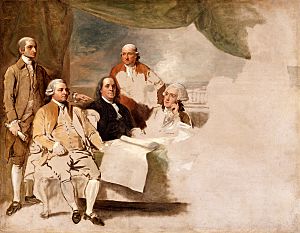
During the American Revolution, American colonists fought for independence. The British, with help from local tribes, attacked American settlements. They captured Detroit in 1776. In 1781, Spanish raiders freed Fort St Joseph from the British. They then gave it to the Americans.
The war ended with the Treaty of Paris (1783) in 1783. Michigan then became part of the new United States. Several states gave up their claims to the land. In 1787, the region became part of the Northwest Territory. Many Native American tribes did not accept the new government. They formed the Western Confederacy. General Anthony Wayne won the Battle of Fallen Timbers. This led to peace and treaties.
The British still held Detroit and other forts. But under the 1794 Jay Treaty, Britain left Detroit and Michilimackinac in 1796. Michigan gained full control of the Upper Peninsula and Drummond Island later.
Michigan was part of Indiana Territory in 1800. Most of it became Michigan Territory in 1805. During the War of 1812, British forces captured Detroit and Fort Mackinac. American troops retook Detroit in 1813. Fort Mackinac was returned in 1815.
After the War of 1812, Native American tribes sold their land claims to the U.S. government. This happened through treaties like the Treaty of Saginaw and the Treaty of Chicago. The government built forts and moved most Native Americans to Indian reservations further west.
In the 1820s and 1830s, many settlers from New England moved to Michigan. These "Yankee" settlers were often from families who had moved from New England to upstate New York. This made Michigan's culture similar to early New England. The Erie Canal helped many people move here. Michigan's population grew very fast in the 1820s.
Michigan's oldest university, the University of Michigan, started in Detroit in 1817. It later moved to Ann Arbor. The Historical Society of Michigan was founded in 1828.
More settlements led to Michigan becoming a state. In 1835, a law was passed to create the State of Michigan. But a land dispute with Ohio over the Toledo Strip delayed statehood. The disputed land went to Ohio. Michigan received the Upper Peninsula as a trade-off. On January 26, 1837, Michigan became the 26th state.
Growth and Change (1837-1900)

Before 1860, farming was the main economic activity. In the early 1840s, large amounts of copper and iron were found in the Upper Peninsula. Michigan became a top source of these ores. Many experienced miners from England came to help.
Michigan was a frontier society until the Civil War. Many pioneers were from New England. This made Michigan a leader in the anti-slavery movement. It also made the Republican Party very strong here. Michigan's focus on public education also came from this New England influence. Many towns were named after places in New England.
Politics and Parties
Before the Civil War, the Democratic Party was powerful. It had many groups, including those who opposed slavery. The Lewis Cass was a key Democratic leader. He ran for president in 1848.
The minority Whig party relied on merchants and farmers. The Whig party broke apart in the 1850s over slavery. Then, the Republican Party formed in 1854. It brought together anti-slavery groups. Republicans became the main party in Michigan for 80 years.
Civil War and After
Michigan played an active role in the American Civil War. Thousands of volunteers joined the fight. At first, there was strong support for the war. But as casualties grew, some called it a failure. Still, Michigan voters remained divided between the parties.
After the war, Michigan's economy grew. In the 1870s, lumbering, railroads, dairy farming, and other industries grew fast. The population doubled between 1870 and 1890.
The state government also set up a strong public school system. It spent more on education than any other state. It created colleges to train teachers.
Railroads were very important for Michigan's growth. They helped move people and goods. This led to more population and industry across the state.
Progressive Ideas
In 1896, Detroit Mayor Hazen Pingree became governor. He was a social reformer. He fought against big corporations. He supported fair taxes and public ownership of services. He also wanted direct election of U.S. senators, an eight-hour workday, and an income tax. He also pushed for an end to child labor.
The Automobile Age (1900-1941)
Michigan's cities grew quickly in the early 1900s. This was thanks to the car industry in Detroit. The breakfast cereal industry also grew in Battle Creek. Many machine shops opened across the state.
Cars and Factories
Manufacturing became Michigan's main source of money. This was largely because of the automobile. In 1897, the Olds Motor Vehicle Company opened in Lansing. In 1903, Ford Motor Company started in Detroit. With the mass production of the Ford Model T, Detroit became the world's car capital.
General Motors was formed a few years later. It bought Oldsmobile, Cadillac, and other car companies. Both Ford and GM built huge factories in the Detroit area. This made Michigan a leader in manufacturing. These factories produced many military vehicles during World War I.
Jackson was also important in the early car industry. It made car parts and assembled cars as early as 1901. Over twenty different car brands were once made in Jackson. Today, the auto industry is still a major employer in Jackson County.
New People Arrive
As industries grew, hundreds of thousands of people moved to Detroit. Many came from the Southern U.S. and from Eastern and Southern Europe. Detroit quickly became the fourth largest city in the country. New housing was built, but there were still housing shortages.
Different ethnic groups formed their own communities. They had their own churches, stores, and clubs. By 1939, students in public schools spoke over 35 languages. Ethnic festivals were common.
Progress and Reform
Michigan's cities were centers of reform during the Progressive Era. Caroline Bartlett Crane became known for her work on city sanitation. She studied housing, schools, and water systems. She found ways to improve them and reduce pollution.
George E. Ellis, mayor of Grand Rapids (1906–16), was a dynamic leader. He worked to include more people in politics. Mayor Hazen Pingree of Detroit (1889–1896) also brought progressive ideas. He fought against corruption and private utility monopolies. He expanded welfare programs and built new schools and parks.
Women's Roles
Most young women worked before marriage. They often left school around age 15. Women's work often depended on their background and if they were married. Many middle-class homemakers started new groups. They worked to improve social welfare and public health. The Detroit Federation of Women's Clubs pushed for better schools, water, and sanitation.
The Great Depression
The Great Depression caused great hardship in Michigan. Many auto workers lost their jobs. Copper mining also declined. The state's economy suffered greatly.
After years of Republican rule, the Democrats gained power. Franklin D. Roosevelt's New Deal programs helped. Washington spent a lot on relief and recovery. This helped cities and changed politics. By 1936, new industrial labor unions, like the United Auto Workers, made factories strongholds for Democrats.
Young men from struggling families joined the Civilian Conservation Corps. They worked in rural areas. The Works Progress Administration hired over 500,000 unemployed people in Michigan. They built roads, public buildings, and sewer systems.
Labor Unions
Labor unions grew quickly after 1935. The Flint Sit-Down Strike of 1936-37 was key for the United Auto Workers Union (UAW). Strikers occupied General Motors plants for over 40 days. GM signed a contract, and UAW membership grew from 30,000 to 500,000 members.
During World War II, Walter Reuther led the UAW. He negotiated for higher wages and better benefits for UAW members.
Michigan After 1941
The United States joining World War II in 1941 ended Michigan's economic problems. The war needed many weapons and military vehicles. This created many new jobs. After the war, both the car and copper mining industries recovered.
Starting in World War I, the Great Migration brought many African-Americans from the South to Michigan. They came for factory jobs, especially in Detroit. More people moved during and after World War II. African Americans brought new music, food, and culture to the cities.
The years after the war were good for factory workers. They earned good wages and moved to better neighborhoods. This was also when Motown Records became popular. However, later in the century, factories closed, and jobs were lost. The economy suffered. Social problems and urban decline led to challenges. In 1967, there was a major event in Detroit that caused much damage. This led to many people moving to the suburbs.
The 1973 oil crisis affected Michigan's economy greatly. Car companies faced more competition from other countries. This led to job losses. Michigan had the highest unemployment rate of any U.S. state in the 1970s. The state cut spending on education and health.
In the 1980s, the car industry improved. This helped the state's finances. But competition from Japanese and South Korean car companies continues. Michigan's government is now working to attract new industries. This will help the state rely less on just the car industry.
Images for kids
-
Gerald Ford, a politician from Grand Rapids, served as House of Representatives member, House Minority Leader, and Vice President. He became the 38th President of the United States after Richard Nixon resigned.





